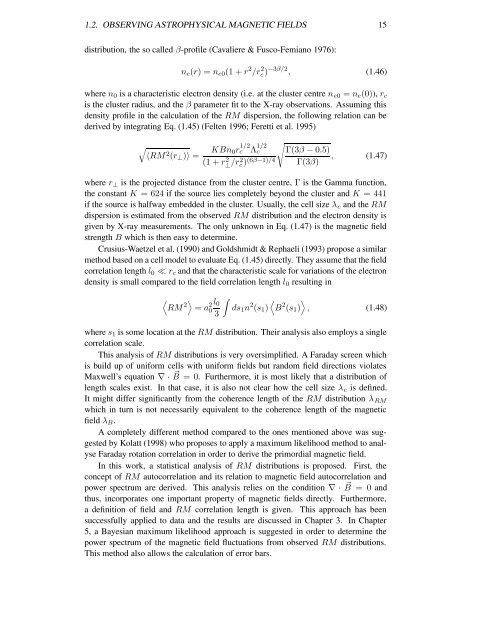Investigations of Faraday Rotation Maps of Extended Radio Sources ...
Investigations of Faraday Rotation Maps of Extended Radio Sources ...
Investigations of Faraday Rotation Maps of Extended Radio Sources ...
Create successful ePaper yourself
Turn your PDF publications into a flip-book with our unique Google optimized e-Paper software.
1.2. OBSERVING ASTROPHYSICAL MAGNETIC FIELDS 15<br />
distribution, the so called β-pr<strong>of</strong>ile (Cavaliere & Fusco-Femiano 1976):<br />
n e (r) = n e0 (1 + r 2 /r 2 c )−3β/2 , (1.46)<br />
where n 0 is a characteristic electron density (i.e. at the cluster centre n e0 = n e (0)), r c<br />
is the cluster radius, and the β parameter fit to the X-ray observations. Assuming this<br />
density pr<strong>of</strong>ile in the calculation <strong>of</strong> the RM dispersion, the following relation can be<br />
derived by integrating Eq. (1.45) (Felten 1996; Feretti et al. 1995)<br />
√〈RM 2 (r ⊥ )〉 = KBn 0rc 1/2 Λc<br />
1/2 √<br />
Γ(3β − 0.5)<br />
(1 + r⊥ 2 , (1.47)<br />
/r2 c )(6β−1)/4 Γ(3β)<br />
where r ⊥ is the projected distance from the cluster centre, Γ is the Gamma function,<br />
the constant K = 624 if the source lies completely beyond the cluster and K = 441<br />
if the source is halfway embedded in the cluster. Usually, the cell size λ c and the RM<br />
dispersion is estimated from the observed RM distribution and the electron density is<br />
given by X-ray measurements. The only unknown in Eq. (1.47) is the magnetic field<br />
strength B which is then easy to determine.<br />
Crusius-Waetzel et al. (1990) and Goldshmidt & Rephaeli (1993) propose a similar<br />
method based on a cell model to evaluate Eq. (1.45) directly. They assume that the field<br />
correlation length l 0 ≪ r c and that the characteristic scale for variations <strong>of</strong> the electron<br />
density is small compared to the field correlation length l 0 resulting in<br />
〈<br />
RM 2〉 ∫<br />
= a 2 l 0<br />
0<br />
3<br />
〈 〉<br />
ds 1 n 2 (s 1 ) B 2 (s 1 ) , (1.48)<br />
where s 1 is some location at the RM distribution. Their analysis also employs a single<br />
correlation scale.<br />
This analysis <strong>of</strong> RM distributions is very oversimplified. A <strong>Faraday</strong> screen which<br />
is build up <strong>of</strong> uniform cells with uniform fields but random field directions violates<br />
Maxwell’s equation ∇ · ⃗B = 0. Furthermore, it is most likely that a distribution <strong>of</strong><br />
length scales exist. In that case, it is also not clear how the cell size λ c is defined.<br />
It might differ significantly from the coherence length <strong>of</strong> the RM distribution λ RM<br />
which in turn is not necessarily equivalent to the coherence length <strong>of</strong> the magnetic<br />
field λ B .<br />
A completely different method compared to the ones mentioned above was suggested<br />
by Kolatt (1998) who proposes to apply a maximum likelihood method to analyse<br />
<strong>Faraday</strong> rotation correlation in order to derive the primordial magnetic field.<br />
In this work, a statistical analysis <strong>of</strong> RM distributions is proposed. First, the<br />
concept <strong>of</strong> RM autocorrelation and its relation to magnetic field autocorrelation and<br />
power spectrum are derived. This analysis relies on the condition ∇ · ⃗B = 0 and<br />
thus, incorporates one important property <strong>of</strong> magnetic fields directly. Furthermore,<br />
a definition <strong>of</strong> field and RM correlation length is given. This approach has been<br />
successfully applied to data and the results are discussed in Chapter 3. In Chapter<br />
5, a Bayesian maximum likelihood approach is suggested in order to determine the<br />
power spectrum <strong>of</strong> the magnetic field fluctuations from observed RM distributions.<br />
This method also allows the calculation <strong>of</strong> error bars.
















